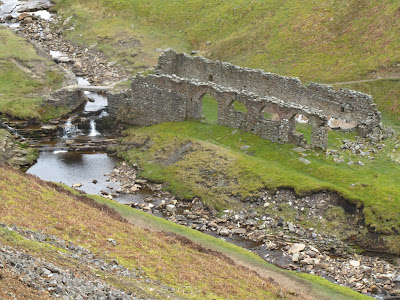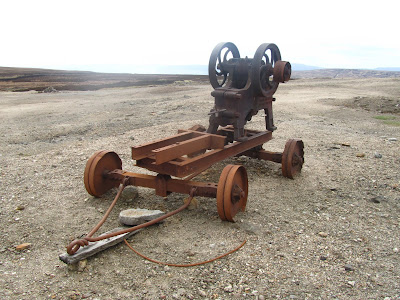Crackpot Hall
 |
| Crackpot Hall overlooking Swaledale |
I have been interested in exploring the ruins of Crackpot Hall ever since learning about it from Julia Bradbury's Coast to Coast programme. This is not only a really interesting building complete with outhouses but it offers some really spectacular views along Swaledale. The buildings had been used as a shooting lodge and farmhouse but have stood empty since the 1950s. For more information read http://en.wikipedia.org/wiki/Keld,_North_Yorkshire
| Crackpot Hall plaque unfortunately missing! |
Swinner Gill Lead Mines
At the point where Swinner Gill and East Grain meet, the footpath crosses a small stone bridge and beneath the bridge you can see how the rocks have been polished slick by hushing, which was a method of mining that used water to reveal mineral veins. As we stopped to take a couple of pictures a fellow walker told us about a cave further up the gill at Swinnergill Kirk that served as a place of worship for Catholics at a time of religious persecution. Here is a walk report in the area for you to read on the excellent Walking Englishman website: http://www.walkingenglishman.com/dales4.htm
Blakethwaite Smelt Mill
I have visited this site twice now, but I think it will remain a sight that I could never tire of. The arches that remain would be just at home on the site of an ancient abbey such as Easby or Egglestone as they are here high up Gunnerside Gill. The kiln is still fully intact and also looks like it was built as part of a castle rather than for the smelt mill. This site started its working life in 1821, smelting ore from the Blakethwaite and Lownathwaite mines.
| looking up to the kiln |
Old Gang Smelting Mill
Coming round a corned along the bridleway heading from west to east, the approach to Old Gang Smelting Mill is an impressive one - evidence of the mining past is all around as you spot a tunnel here, another level there before spying the collection of buildings in the distance. It's quite amazing to think the network of tunnels stretches all the way back to Gunnerside Gill. There is a lot still to see here with the tall chimney dominating the scene. There is a good walk described in Paul Hannon's "Walking Country - Swaledale" book which takes in this site and offers plenty of background information.
Surrender Lead Smelt Mill
Dating from around 1840, this old mill and peat house is not too far from Surrender Bridge. It is a grade 2 listed building and was built to replace a mill from 1680. For more information about the mines of Yorkshire have a look at this excellent site: http://www.martinroe.pwp.blueyonder.co.uk/
High up on the moors heading towards the Old Gang Smelting Mill on what is almost a lunar landscape we came across this disused stone-breaking machine, I wonder if it has been left up there as a momento of an industrial time gone by?
This article goes into much more detail about the lead mining history of the northern Dales and is well worth a read: http://www.outofoblivion.org.uk/lead.asp






No comments:
Post a Comment